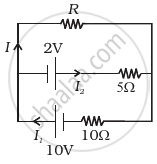Advertisements
Advertisements
Question
State Kirchhoff's rules for an electric network. Using Kirchhoff's rules, obtain the balance condition in terms of the resistances of four arms of Wheatstone bridge.
Solution
Kirchhoff’s First Law − Junction Rule
The algebraic sum of the currents meeting at a point in an electrical circuit is always zero.

Let the currents be I1, I2I3, and I4
Convention:
Current towards the junction − positive
Current away from the junction − negative
I3 + (− I1) + (− I2) + (− I4) = 0
Kirchhoff’s Second Law − Loop Rule
In a closed loop, the algebraic sum of the emfs is equal to the algebraic sum of the products of the resistances and current flowing through them.
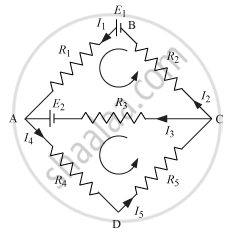
For closed part BACB, E1 − E2 = I1R1 + I2 R2 − I3R3
For closed part CADC, E2 = I3R3 + I4R4 + I5R5
Wheatstone Bridge:
The Wheatstone Bridge is an arrangement of four resistances as shown in the following figure.
R1, R2, R3,and R4 are the four resistances.
Galvanometer (G) has a current Ig flowing through it at balanced condition, Ig = 0
Applying junction rule at B,
∴ I2 = I4
Applying junction rule at D,
∴ I1 = I3
Applying loop rule to closed loop ADBA,
`-I_1R_1+0+I_2R_2 = 0`
`∴ I_1/I_2 = R_2/R_1 ...... (1)`
Applying loop rule to closed loop CBDC,
`I_2R_4+0-I_1R_3 = 0` ∵`I_3 =I_1,I_4 =I_2`
`∴ I_1/I_2 = R_4/R_3 ...... (2)`
From equations (1) and (2),
`R_2/R_1 = R_4/R_3`
This is the required balanced condition of Wheatstone Bridge.
APPEARS IN
RELATED QUESTIONS
State the two Kirchhoff’s rules used in electric networks. How are there rules justified?
Given the resistances of 1 Ω, 2 Ω, 3 Ω, how will be combine them to get an equivalent resistance of 6 Ω?
Using Kirchhoff’s rules determine the value of unknown resistance R in the circuit so that no current flows through 4 Ω resistance. Also find the potential difference between A and D.
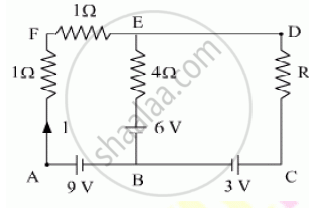
In the given circuit, assuming point A to be at zero potential, use Kirchhoff’s rules to determine the potential at point B.

Consider the potentiometer circuit as arranged in the figure. The potentiometer wire is 600 cm long. (a) At what distance from the point A should the jockey touch the wire to get zero deflection in the galvanometer? (b) If the jockey touches the wire at a distance of 560 cm from A, what will be the current in the galvanometer?
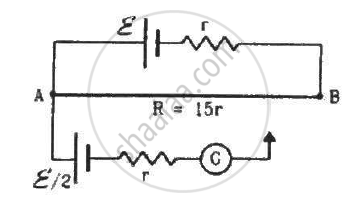
On which conservation principle is Kirchoff's Second Law of electrical networks based?
How the emf of two cells are compared using potentiometer?
The e.m.f of The battery in a thermocouple is doubled. The rate of heat generated at one of the junction will.
Three resistors having resistances r1, r2 and r3 are connected as shown in the given circuit. The ratio `i_3/i_1` of currents in terms of resistances used in the circuit is: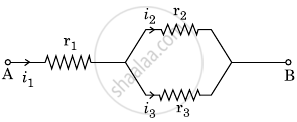
Two cells of voltage 10V and 2V and internal resistances 10Ω and 5Ω respectively, are connected in parallel with the positive end of 10V battery connected to negative pole of 2V battery (Figure). Find the effective voltage and effective resistance of the combination.
